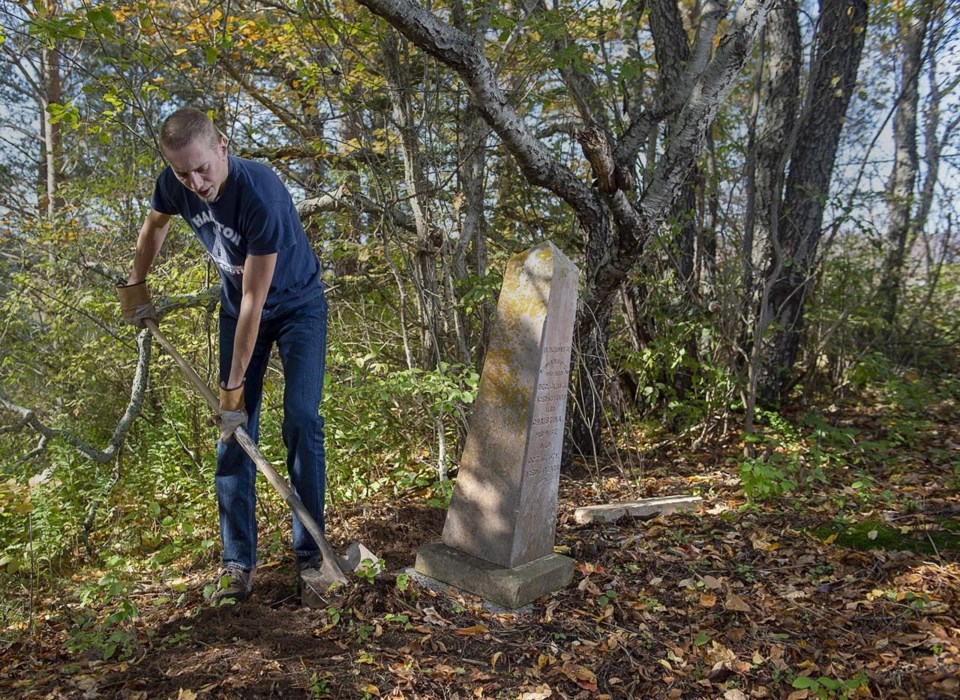HALIFAX — A secluded and overgrown cemetery in rural Cape Breton, the final resting place for some of Nova Scotia's earliest settlers, is slowly crumbling into a nearby river.
"They would be descendants of the Scots ... who came over here and settled," says Bruce Morrison, warden of  Victoria County, where fishing and tourism are the main employers. "There's no simple solution to this. It's isolated. It's remote."
But local resident Jeffrey Parks says the graves in the Centre Glen Cemetery near Big Baddeck, many of which date back to the 1860s, should be saved from such an ignominious fate.
"Nobody is doing anything about it because everyone is pointing fingers at who's responsibility it is," says Parks, an antiques dealer from nearby Middle River, N.S.
At least three headstones have already fallen into a river bend that is carving soil away from the edge of the site.
"I have hundreds of old photos of people with no names to them," Parks says, referring to his antiques business. "And now, their graves are being washed away .... I don't want this to happen to me when it's 100 years from now."
Last year, Parks retrieved from the water a headstone with the name Alexander MacLeod inscribed on its face. Born in 1842, MacLeod was buried in 1906. The marker includes the name of his wife, Sarah MacAulay, who died in 1943, and two of the couple's sons: James was 22 when he died in 1912, and Roderick died in 1926 at the age of 32.
The remaining headstones can be found amid an unruly thicket of brambles and, at this time of year, rising above a heavy layer of snow. The road to the cemetery is long gone. The rough path that remains isn't easy to find.
Parks says he believes at least ten graves have been claimed by the river. In the past two years, he's found some coffin handles, and he knows of one man who says he found the top half of a skull about a kilometre away.
"It's disheartening," Parks says, adding he's learned of several other cemeteries lost decades ago when logging companies cut new roads deep into the bush, unaware of the isolated burial grounds.
Morrison says the county has no less than 20 abandoned graveyards, many of them progressively succumbing to erosion caused by rivers, lakes or the open ocean.
"At one time, every small community had a church and every small community had a cemetery," he said in a recent interview. "But many of those communities moved on and the remnants of those communities were left in the graveyards."
In April 2014, a human skull and other bones were found protruding from a cliff at the edge of the United Church cemetery in Ingonish, N.S., a picturesque village in Victoria County where the Atlantic Ocean provides a striking view.
At the time, church officials said they didn't have to money to stabilize the steep bank. Some of the graves there are more than 200 years old.
Morrison says it would be expensive to save all of the county's neglected cemeteries. That's why he's encouraging community groups to ask the provincial government for help.
"The problems are as varied as the number of cemeteries," he said.Â
It's a provincewide predicament, as illustrated by the 9,000 members of the Facebook group called Abandoned Cemeteries of Nova Scotia. Its page features scores of photos of decrepit, orphaned gravesites and plenty of pleas for help.
The group's administrator, Nova Scotia author Steve Skafte, published a book last year titled "The Dead Die Twice: Abandoned Cemeteries of Nova Scotia."
Skafte says the grim title refers to the fact that we all die twice — once in life, then again in memory.Â
He has made it his mission to resurrect some of these battered monuments to Nova Scotia's history. In the past three years, he and other graveyard sleuths have found more than 100 forgotten cemeteries. And the amateur photographer and historian has personally rejuvenated some of them.
"All the brush you find, it's in the way of the history," Skafte said in a 2021 interview with The Canadian Press. "As soon as you peel that back, it feels like you're almost right when it happened."
This report by The Canadian Press was first published Jan. 7, 2024.
Michael MacDonald, The Canadian Press



